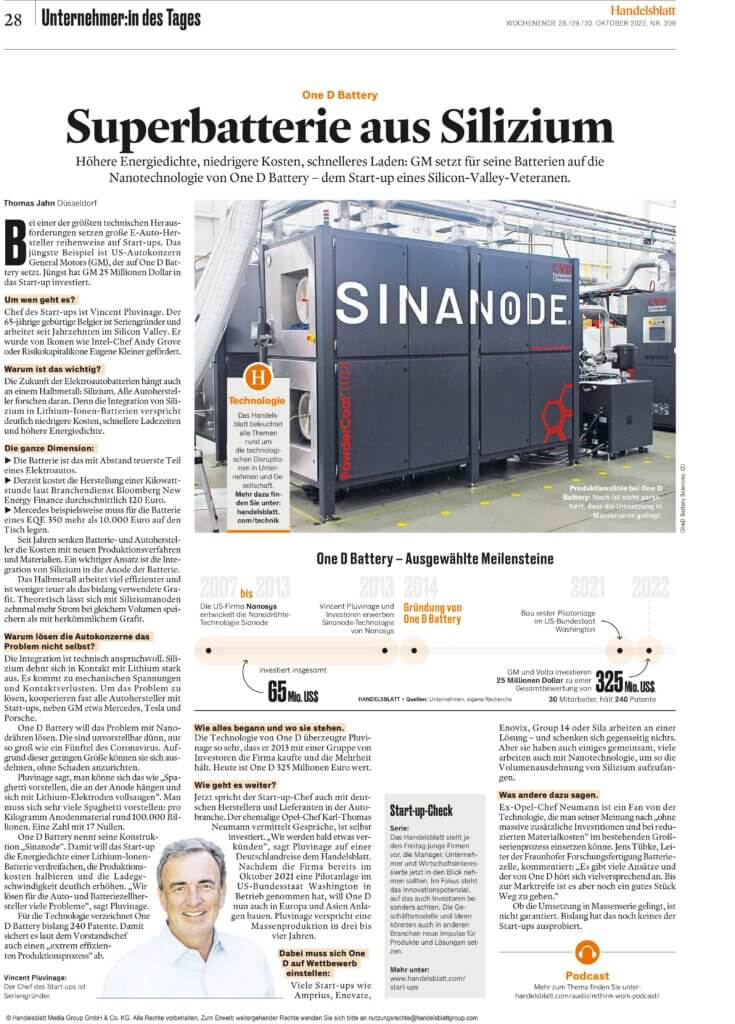Higher energy density, lower costs, faster charging: For its batteries, GM relies on the nanotechnology of OneD Battery – the start-up of a Silicon Valley veteran.
In one of the greatest technical challenges, large e-car manufacturers are relying on start-ups in droves. The most recent example is the US car company General Motors (GM), which is based on OneD Battery Sciences. GM recently invested $25 million in the start-up.
Who is the person we are talking about?
The start-up is headed by Vincent Pluvinage. The 64-year-old Belgian is a serial entrepreneur, and he has been working in Silicon Valley for decades. Early in his career, he was supported by icons such as Intel CEO Andy Grove and venture capital icon Eugene Kleiner.
Why is that important?
The future of electric car batteries depends on a semi-metal: silicon. All car manufacturers are researching it. The integration of silicon in lithium-ion batteries promises significantly lower costs, faster charging times and higher energy density.
The context:
- The battery is by far the most expensive part of an electric car.
- According to the industry service Bloomberg New Energy Finance, EV batteries currently cost an average of 120 euros per kilowatt hour.
- Mercedes, for example, must pay more than 10,000 euros for the battery of an EQE 350.
For years, battery and car manufacturers have been reducing costs with new production processes and materials. An important approach is the integration of silicon in the anode of the battery. The semi-metal works much more efficiently and is less expensive than the graphite used up to now. Theoretically, this leads to anodes with more silicon.
OneD Battery wants to solve the problem with nanowires. They are unimaginably thin, only the size of a fifth of the corona virus. Because of their very small size, they can expand without causing damage.
Pluvinage says you can think of nanowires like “spaghetti hanging in the anode and soaking up lithium electrodes.” You must imagine a lot of spaghetti: around 100,000 trillion per kilogram of anode material. A number with 17 zeros.
OneD Battery calls its technology “SINANODE”. With this technology, the start-up can to triple the energy density of a lithium-ion battery anodes; halve the costs and significantly increase the charging speed.
“We solve many problems for car and battery cell manufacturers,” says Pluvinage. To protect the SINANODE technology, OneD Battery has secured 240 patents so far. According to the CEO, it also ensures an “extremely efficient production process”.
How it all started and where they are.
After studying the SINANODE technology in 2013, Pluvinage was so convinced that he and a group of investors bought it from Nanosys. Today, this group of investors holds the majority of the equity and OneD is worth 325 million euros.
What’s next?
Now the start-up boss is also talking to German manufacturers and suppliers in the automotive industry. Former Opel boss Karl-Thomas Neumann mediates talks and has personally invested in OneD.
“We’ll soon announce more partnerships,” says Pluvinage on a trip to Germany to the Handelsblatt.
After the company started commissioning a pilot plant in the US state of Washington in October 2021, OneD now also wants to build additional pilot plants in Europe and Asia.
Pluvinage promises mass production in three to four years.
In doing so, OneD must also focus on a set of competitors. Many startups like Amprius, Enevate, Enovix, Group 14 or Sila are also working on a solution. But they all also have something in common: silicon nanotechnology is required to deal with the volume expansion of silicon.
What others say about it.
Former Opel boss Neumann is a fan of the technology, which he believes can be used in the existing mass production process “without massive additional investments and with reduced material costs”.
Jens Tübke, Head of Fraunhofer Battery Cell Research Manufacturing, comments: “There are many approaches and OneD’s sounds promising. However, there is still a long way to go before it is ready for the market.”
Whether the implementation in mass production will succeed is not guaranteed. So far, none of the start-ups have done that yet.
~ Thomas Jahn

